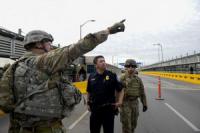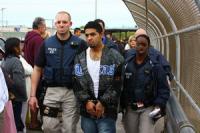-
Judge Allows Administration’s Restrictive Asylum Rule to Stand

A federal judge on Wednesday said he would not block a new rule which effectively bars most migrants from Central America and other countries from seeking asylum at the U.S.-Mexico border. Analysts say the rule amounts to a seismic change in U.S. approach to asylum seekers. The rule restricts access to the U.S. asylum system for non-Mexican migrants who traveled through Mexico and other countries in order to reach the U.S. border — but who did not seek protection in those nations.
-
-
A Framework for a Fair, Humane, and Workable Immigration Policy
The immigration debate in America today is nearly as broken as the country’s immigration system itself. The other day, the Center for American Progress released a new report which provides a framework to fix both. CAP notes that for many years, conversations about immigration have been predicated on a false choice that says America can either honor its identity as a nation of immigrants or live up to its ideals as a nation of laws by enforcing the current broken immigration system. Tom Jawetz, the report’s author, argues that by accepting these terms of the debate, supporters of sensible immigration policy have ceded powerful rhetorical ground to immigration restrictionists.
-
-
Criminal Prosecutions and Illegal Entry: A Deeper Dive
Since the first Democratic presidential debates at the end of June, candidates, pundits and former government officials have discussed whether provisions of law that turn unauthorized border crossing into the federal crime of “improper entry” – in addition to a civil immigration law violation – should be repealed. Over the last three years, researchers at Human Rights First have conducted extensive research and observed countless entry and re-entry prosecutions in Arizona, California, New Mexico and Texas. These prosecutions, as we have detailed in a series of reports, violate U.S. refugee treaty obligations, impinge on due process, separate children from their parents, waste government funds, and divert prosecutorial resources from serious criminal and security threats.
-
-
“Safe Third Country” Agreements with Mexico and Guatemala Would Be Unlawful
News reports that the United States seeks to sign “Safe Third Country” agreements with Mexico and Guatemala – possibly as soon as today – mark the latest phase in the Trump Administration’s efforts to keep Central American asylum seekers from reaching the country. Such agreements would bar asylum applications in the United States from thousands fleeing El Salvador and Honduras, as well as claimants from other world regions who transit Central America and Mexico to reach our border. And they would be contrary to both U.S. and international law on the protection of asylum seekers.
-
-
Child Separation Policy: Allegations of Mistreatment Substantiated
Between April 2018 and June 2018, the Trump administration separated at least 2,800 children from their parents under the “zero tolerance” policy. Among other disturbing things, a new staff report by the Committee on Oversight and Reform found that at least 18 infants and toddlers under two years old were taken away from their parents at the border and kept apart for 20 days to half a year; at least 241separated children were kept in Border Patrol facilities longer than the 72 hours permitted by law; and that the administration separated children unnecessarily—even under its own rationale.
-
-
Lack of Data on Missing Migrant Children Leads to Gaps in Protection
A new report highlights the need for better data on migrant deaths and disappearances, particularly those of missing migrant children. The report says that nearly 1,600 children have been reported dead or missing since 2014, though many more go unrecorded.
-
-
We Treat America’s Wartime Detainees Better than Migrant Children
The stories of mistreatment, neglect, and abuse of migrant children held in U.S. government detention proliferate. Ryan Vogel writes that “the standards for treatment of detained persons in wartime are not the same as those required in peacetime immigration situations” – in fact: “in most instances, if not all, migrant children held in temporary government custody should be detained in conditions superior to those of enemy fighters detained during wartime.” He adds: “It is a moral issue. As a nation, we decided that the United States would meet and surpass all legal requirements for our wartime detainees. We determined that even though al Qaeda and other terrorist groups would never reciprocate, we would treat them humanely and with dignity. That we would go above and beyond the minimal standards of the Geneva Conventions and hold ourselves to a higher standard. And that we would hold our people accountable for any and all violations of these standards. We have done that with wartime detention. It is time we did that, and much more, for our detention of migrant children.”
-
-
ICE Deportation Raids to Start Sunday
U.S. officials reportedly plan to start immigration raids on Sunday and are expected to target at least 2,000 undocumented people for whom deportation orders have been issued, some as a result of their failure to appear in court for immigration proceedings.
-
-
In El Paso Court, Migrants No Longer Get Legal Advocates or Pre-hearing Briefings on Their Rights
El Paso’s backlogged immigration court recently halted programs designed to aid asylum seekers as they navigate a complicated legal system. “The confusion in the courtroom is palpable,” says one advocate.
-
-
To Stem the Flow of Refugees, Address the Conflicts at Its Core
The growing number of Central American refugees reaching the U.S. southern border adds to the unfathomable record of 70.8 million people counted globally as of December who had fled their homes as a result of war, persecution, and other conflict, according to a new report from the United Nations.
-
-
To Stem the Flow of Refugees, Address the Conflicts at Its Core
The growing number of Central American refugees reaching the U.S. southern border adds to the unfathomable recordof 70.8 million people counted globally as of December who had fled their homes as a result of war, persecution, and other conflict, according to a new report from the United Nations. The figure represented an increase of 2.3 million from a year earlier. More than 41 million sought sanctuary within their own countries. And almost 26 million had crossed borders and were officially classified as refugees, half of them children. The remaining 3.5 million of the total were awaiting decisions on applications for asylum to find refuge abroad. Viola Gienger writes in Just Security that the report by the U.N. refugee agency on 19 June drew wide attentionfrom news media. But, as has been the case for years, most of the talk of possible solutions — including for the current migration crisis at the southern border of the United States – focuses on how to handle the never-ending flow of people: how to resettle them, how to secure their rights, whether to build a wall or send them back. “What oddly gets short shrift is the most durable solution of all: resolving the violent conflicts and persecution that are driving people from their homes in the first place,” Gienger writes.
-
-
DHS Chief Orders Probe of Agents' Offensive Facebook Posts

DHS secretary on Wednesday ordered an immediate investigation into a report that current and former U.S. Border Patrol agents are part of a Facebook group that posts racist, sexist and violent comments about migrants and Latin American lawmakers.
-
-
Mexicans in U.S. Routinely Confront Legal Abuse, Racial Profiling, ICE Targeting and Other Civil Rights Violations

Officially, the Constitution of the United States gives everyone on U.S. soil equal protection under the law – regardless of nationality or legal status. But, as recent stories of the neglectful treatment of migrant children in government detention centers demonstrate, these civil rights are not always granted to immigrants.
-
-
People want to donate diapers and toys to children at Border Patrol facilities in Texas. They’re being turned away.

The substandard living conditions in Border Patrol facilities holding migrant children have been described in great detail over the past few weeks. Last week, an attorney for the U.S. Department of Justice argued in court that the government shouldn’t be required to give migrant children inside Border Patrol detention facilities toothbrushes, soap, towels, wipes, diapers, blankets, or showers. A Border Patrol official told a Texas state lawmaker that the agency doesn’t accept donations for facilities where children are reportedly being held in substandard conditions.
-
-
Does Europe need migrants?
A European Commission-IIASA flagship report has found that an increase in the EU population aged 65+ is certain – regardless of higher fertility or migration. However, raising labor force participation (particularly for women) and improved education of natives and migrants have the power to nullify aging-related worries.
-
- All
- Regional
- Water
- Biometrics
- Borders/Immig
- Business
- Cybersecurity
- Detection
- Disasters
- Government
- Infrastructure
- International
- Public health
- Public Safety
- Communication interoperabillity
- Emergency services
- Emergency medical services
- Fire
- First response
- IEDs
- Law Enforcement
- Law Enforcement Technology
- Military technology
- Nonlethal weapons
- Nuclear weapons
- Personal protection equipment
- Police
- Notification /alert systems
- Situational awareness
- Weapons systems
- Sci-Tech
- Sector Reports
- Surveillance
- Transportation
Advertising & Marketing: advertise@newswirepubs.com
Editorial: editor@newswirepubs.com
General: info@newswirepubs.com
2010-2011 © News Wire Publications, LLC News Wire Publications, LLC
220 Old Country Road | Suite 200 | Mineola | New York | 11501
Permissions and Policies
Editorial: editor@newswirepubs.com
General: info@newswirepubs.com
2010-2011 © News Wire Publications, LLC News Wire Publications, LLC
220 Old Country Road | Suite 200 | Mineola | New York | 11501
Permissions and Policies
